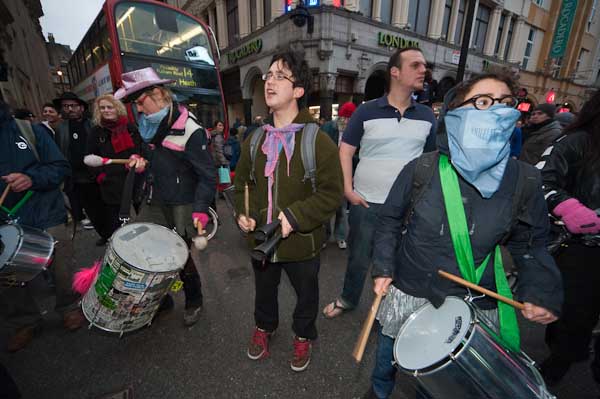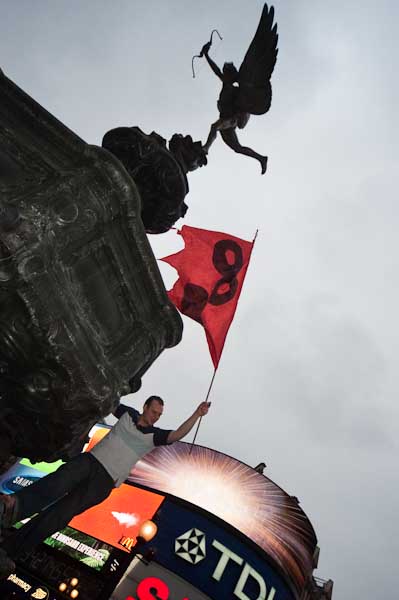The second demonstration I photographed last Saturday was much smaller than the 1500 or so photographers in Trafalgar Square, and I could actually count the number taking part. So when I wrote in my account that “more than 150 people” were in the march from St Pancras to Piccadilly Circus there isn’t much room for argument. Of course, it’s still deliberately a little vague, both because the actual number isn’t of any interest and that it is pretty well impossible to get an exact count.
In some ways it’s much easier to cover small events – and not a great deal is likely to happen without you noticing it, whereas your view of a large event can be quite different to that of someone working on the far side away from you.
NoBorders, whose London group organised the demonstration, would like people to be allowed to move freely around the world without the kind of border controls that most states now impose. Seeing the problems that the attempts by the UK to restrict migration to this country have caused, with thousands locked up inside our immigration prisons and so many cases of injustice and inhumanity I feel they have a very strong case; whatever problems free movement might cause I think they would be less.
At the very least we should set up a humane system that recognises our historic liabilities and our obligations under international agreements and human rights declarations, and gives those seeking asylum proper access to our legal system with similar rights to our citizens. What we have are prisons run for private profit, hired thugs and fast-track procedures that deny justice. And an immigration minister who thinks it appropriate to say “The UK Border Agency vigorously opposes any appeal against deportation” rather than feeling it is the duty of the Asylum and Immigration Tribunal to come to a decision on the facts of the case.

Sometimes you can go too wide on the 12-24mm
I was without the Sigma 24-70mm f/2.8 EX DG MACRO which has become my favourite lens, as I finally had to send it back to Sigma for repair. Something came a little loose inside a few months ago and it has clearly been getting worse. So I was working with my old Sigma 12-24mm EX on the D700 full frame and a Nikon 18-200mm on the DX D300 (equivalent to 27-300mm.)

But at times it’s rather fun to do so
The 12-24 is a great lens (and the current version is better still), but considerably more useful on the DX format, where it becomes an ’18-36 equivalent’. On full frame it not surprisingly gives some considerable vignetting at the wide end, and 12mm is really just too wide for any rectilinear lens. There is an unavoidable wide-angle distortion – a matter of geometry rather than lens design. On DX format it gives the same view as an 18mm on full frame which is much more usable, and also has better sharpness and less chromatic aberration because it avoids the extreme corners of the lens. At ’18-36′ it covers the whole of the usable rectilinear wide-angle range. Should you need a wider view (and I sometimes do) the answer is a fisheye – such as the 10.5mm Nikon.
On the FX camera, the 12-24 also abandons you at the longer end, bang in the middle of the useful wide-angle range at 24mm. This is a pain if you only have a single camera, but less so if you can simply pick up your second body. The 18-200 on the DX300 starts at a 27mm equivalent, giving you an almost seamless range of focal lengths.
This is a sort of reversal of my normal practice, where I rely on the DX300 for the wider stuff (with both the 10.5 fisheye and either the Sigma 12-24 or the smaller DX format only 10-20mm.) Then the DX700 with the 24-70mm covers the whole of the middle range (and often it is everything I need), switching back to a cheap and light Sigma 55-200 DX lens on the D300 for any long stuff.
If Sigma made a decent full frame 50-200mm I would probably buy one; the old DX version more or less covers full frame – at least after I took a hacksaw to the lenshood – as I mentioned in an earlier post.
The closest match they have in is 70-300mm, with 3 versions available. The extra focal length does make them a little heavier and bulkier than a 50-200 would be. Having the 70-300mm f/4-5.6 DG MACRO, 70-300mm f/4-5.6 APO DG MACRO and the 70-300mm f/4-5.6 DG OS does seem a little overkill. The OS is an optically stabilised lens, but the APO offers better quality if you can hold it still, while the first mentioned is cheaper.
None of these three are in their professional EX range with “superior build and optical quality”, which does offer the large and heavy 70-200mm f/2.8 EX DG MACRO HSM II, doubtless an excellent lens but too large and heavy for me.

’89’ was the year the Soviet bloc crumbled
More from Life is too short to be controlled.